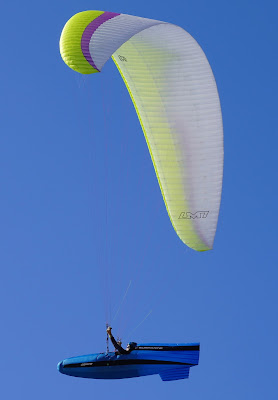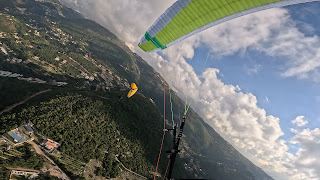GIN Bonanza 3 S (85-100)
The GIN Bonanza 3 is the 2023-25 new EN-C, 2- liner glider that replaces the Bonanza 2 which was a 3-liner with a 6.4 aspect ratio.
The Bonanza 3 only has one A and one B. It is a pure 2-liner with a 6.3 aspect ratio and equipped with GIN’s new wave leading edge that was implemented on their CCC glider the Boomerang 12.
GIN uses on the upper surface leading edge: Myungjin MJ40 MF and Myungjin MJ32 MF and on the Lower surface: Porcher Skytex, 27 g/m².
The lines are a mix of: 8001 / 050 / 070 / 090 / 130 / 190 / 230 / 280 / 340 (unsheathed aramid)
The overall construction and details are really nice with excellent workmanship.
The Bonanza 3 launches easily in nil wind and the rise is straightforward, without any hard point or delay. In stronger air above 20 km/h, it is also very easy to launch and quite manageable in correcting it if needed, and the take-off is very quick.
I flew the Bonanza 3 from 94 to 97. In all those weights it will behave very taught and forgiving. The B3 was flown in weak air to some stronger air, and finally, the feedback from my friends and I was unanimous by the easiness and high comfort of the Bonanza 3 in active air. It resembles the comfort of the Alpina 4 if any pilot had a run on it. For a 2-liner it has similar comfort as to the Volt 4 with an even more coherent and solid structure.
I found out the stall speed is very low as if the glider is telling you or informing you that you have a little more to hold…And in tight turns, when you apply a bit more brake impute into a turn, the Bonanza 3 informs you that you also have a margin before a spin! It is for me a new feel under that glider, and I can only say that the wave leading edge has something to do with that specific feel, never felt before on any other wing.
The stall and spin will eventually happen, but there’s something that delays them if you listen carefully to the glider.
The turning behavior and brake travel feel exactly similar to the Bonanza 3 which was excellent, but without the excessive movements that were on the B3. The brake travel is short to moderate with a more forgiving length. The Bonanza 3 responds well to pilot input in all conditions, even in nasty ones, and the authority on the brakes is really high giving the pilot that extra feel of control in moving air. The brake could be described as, linear and responsive thought out the range. To give an example, it resembles the Alpina 4 brake response but with a more linear feel. Overall it is quite agile.
The Bonanza 3 doesn’t have pitch behavior at all. no back pitch nor front. The roll also is very balanced without being dull or dynamic. That’s why it is so comfortable in thermals. In strong cores, the Bonanza 3 slows a bit before entering, slightly more than the Artik-R but climbs well when it enters. Some gliders surge through the thermals and climb going forward. The B3 is a calm glider in that matter. Flying it at 100 could improve the faster entry in stronger air and windy days. But even at 95 all up, it climbs well in overall conditions.
Climb rate:
One of the strongest points of the B3 is the climb in very weak thermals, as it showed me a very good float ability in those small thermals. I think it is as efficient as the LT2 in that matter, putting it among the top gliders' efficiency in weak thermals.
It feels as if the B3 holds into the weak thermal and embraces it.
Comfort:
Another strong point is the comfort level it offers. It could be probably that wave leading edge, that gives you a feel of a very secure and strong passive safety.
The difference over the Bonanza 2 other than the overall performance of climb and glide angle especially at speed, is the amazing comfort of that 2-liner C.
Glide angle:
I did many glides with the Bonanza 3. glided with the Zeno 2, which I will immediately say that the Z2 is from another further level of glide efficiency. Of course, I am not comparing it to the Zeno 2! But it is just an idea to know.
I also did glide with the Artik-R same size and wing load, and also with the UP Trango-X also the same size as the B3 and the same load. The glide angle at the trim and at bar is very close to the new 2 liners like the Volt 4 for example. I will update my 2 liner C comparison for the little details. But as far so good for the overall package it offers.
Ears:
Ears are doable with outer A’s, and also with outer B’s. In both cases, they are efficient and easy to use with a little more pressure if you use the A-lines. But with hands high and a bit more persistent, it will close well. The opening is sometimes without pilot intervention.
Pleasure under the Bonanza 3:
The moderate brake pressure and brake structure offer very nice agility and authority on the brakes giving the pilot an enjoyable ‘cool’ experience under the B3 making it pleasurable to fly for that specific category.
Usability:
Please keep in mind that it is not a high-B glider…The Bonanza 3 is a 2-liner C model, for that specific targeted group of pilots. But it will require no more than a C pilot under it.
For example, a Bonanza 2 pilot would find it easier to fly than his old model. Pilots on low-rated B gliders would be better to get a season or two on their high Bs before going for the Bonanza 3 which is logical for a safe evolution.
B steering:
The B steering on the B3 while stepping on your speed bar is a nice experience with that efficient tool to keep the glider overhead. The pressure is moderate and balanced without being hard or soft. Just what it takes to have long XCs without being tired.
Speed:
The trim speed is close to the Artik-R. The top speed is very usable, with moderate pressure on the speed bar delivering around 12 km/h over trim at 1000 ASL with a solid leading edge.
Conclusion:
Again, manufacturers are trying to deliver easy 2-liner C machines for newcomers to that class without being overwhelmed by excessive feedback. The Bonanza 3 follows that path with its pleasurable and comfortable feel. An EN-C pilot would feel at home under it.
NOTE:
Please remember the C class requirements:
EN-C Certified Paragliders are designed for intermediate pilots who possess good “active piloting” skills and are quite familiar with recovery techniques. The pilot must fully understand the implications of flying a glider with reduced passive safety. Pilots should possess an advanced rating or certification, and have logged HUNDREDS of flight hours in ALL conditions (especially thermic). An “SIV” or “Advanced Maneuvers” Clinic should be completed by pilots flying EN-C Paragliders.


















































